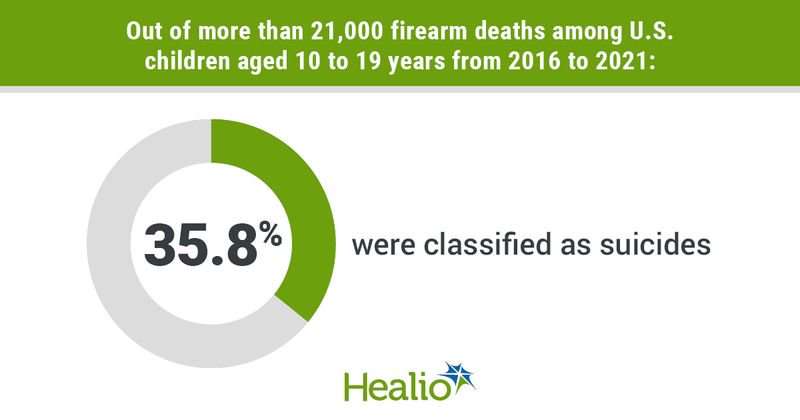Suicides account for more than half of youth firearm deaths in 19 states
Key takeaways:
- Alaska had the highest rates of both firearm deaths and firearm suicides.
- One author suggested implementing lethal means counseling for parents of children with mental health emergencies.
Among people aged 10 to 19 years who died due to firearms during a recent 6-year period, more than half of the deaths in 19 states were attributed to suicide, according to a study published in JAMA Pediatrics.
This was also found to be true for young adults aged 20 to 24 years in 24 states.

Two years ago, the AAP issued a policy statement recommending that firearms — which remain the leading cause of death among youth in the United States — be regulated on the level of motor vehicles, with requirements for training, licensing, insurance coverage and registration.
A study published last month found that firearm suicides among children aged 10 to 19 years increased across genders, races and ethnicities since 1999. The new study found variations in state data.
“When looking at the proportion of firearm deaths among youth from suicide, we noticed that some states looked very different,” Lois K. Lee, MD, MPH, FAAP, FACEP, an emergency medicine physician at Boston Children’s Hospital and associate professor of pediatrics and emergency medicine at Harvard Medical School, told Healio.
Lee said one of the study’s coauthors, Rebecca C. Bell, MD, MPH, “observed the vast majority of firearm deaths in her home state of Vermont were due to suicide. This is very different than if you look at aggregated national data, where approximately 60% of firearm deaths are due to homicide and 30% are due to suicide.”
Lee and colleagues studied scanned the CDC’s publicly available Web-based Injury Statistics Query and Reporting System for data on fatality rates per 100,000 youth aged 10 to 24 years for all firearm fatalities, and then specifically for suicide for each state in the U.S. They then calculated the proportion of firearm deaths due to suicide for two different age groups: 10 to 19 years and 20 to 24 years.
“We separated out young adults 20 to 24 years old because they have much higher firearm fatality rates compared to adolescents 10 to 19 years old,” Lee said.
‘Extremely concerning’
In all, the researchers found that a total of 21,173 firearm deaths had occurred among children aged 10 to 19 years from 2016 to 2021, of which 35.8% were suicides. Firearm death rates per 100,000 children were highest in Alaska (20.49), Louisiana (19.36), Mississippi (16.59), Alabama (14.78) and Missouri (14.78).
Alaska also had the highest rate of firearm suicides at 13.02 per 100,000 children, followed by Wyoming (10.92), Montana (10.3), Idaho (6.83) and North Dakota (6.34).
Additionally, in six states — Idaho, Montana, Wyoming, North Dakota, New Hampshire and Maine — suicide accounted for more than 75% of firearm deaths in children, and in 13 other states, suicide accounted for between 51% to 75% of all firearm deaths.
“Although we expected there would be differences by state, we did not realize how many states would have over 50% of firearm deaths due to suicide,” Lee said. “We find it extremely concerning that in nearly half the states, firearm suicide accounts for over 50% of firearm deaths among those 10 to 24 years old.”
Message for providers
Primary care providers and pediatricians, “can play an important role in discussing secure firearm storage for households with firearms,” according to Lee.
“This is because decreasing access to lethal means — like firearms — is important for firearm suicide prevention,” Lee said. “For youth with known risk factors for suicide, lethal means counselling to securely store not just firearms, but medications and sharp objects, is very important.”
Lee said suicide can be impulsive, making it difficult to predict who might attempt it.
“Secure storage of firearms — which means, ideally, separating the firearm and the ammunition, and securing and locking both of these away separately — is important in households with children and youth,” Lee said. “It is also important to discuss other storage options for those who keep loaded firearms in the home.”
This can include firearm lockboxes, which Lee said can be easily accessed by the authorized firearm user — such as with a handprint — but not by children in the home.
Lee also recommended that emergency medicine and mental health clinicians conduct lethal means counseling with families when patients present with mental health emergencies and advocate for strategies such as:
- advancing laws for extreme risk protection orders;
- establishing policies that hold adults accountable if kids gain access to firearms, such as child access protection laws;
- contacting government resources so that medical offices can provide gun safes and gun locks to families cannot afford them; and
- more widely implementing technological solutions so that only gun owners can fire the weapon, such as with fingerprint identifiers that allow only the authorized user to pull the trigger.
“Access to firearms is one of the most important factors increasing the risk of firearm suicide,” Lee said. “Interventions focusing on decreasing firearm access in these states could help protect kids from suicide.”
For more information:
Lee directed those interested in more information to healthychildren.org.
